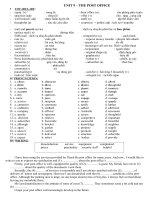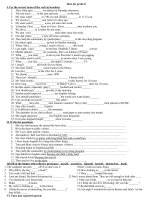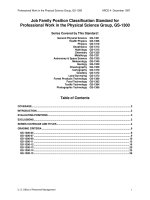performance standard for shipboard voyage data recorder VDR MÁY ĐIỆN HÀNG HẢI
Bạn đang xem bản rút gọn của tài liệu. Xem và tải ngay bản đầy đủ của tài liệu tại đây (24.6 KB, 7 trang )
A 20/Res.861
3 December 1997
Original: ENGLISH
ASSEMBLY
20th session
Agenda item 9
RESOLUTION A.861(20)
adopted on 27 November 1997
PERFORMANCE STANDARDS FOR SHIPBORNE
VOYAGE DATA RECORDERS (VDRs)
THE ASSEMBLY,
RECALLING Article 15(j) of the Convention on the International Maritime Organization
concerning the functions of the Assembly in relation to regulations and guidelines concerning maritime
safety,
RECALLING ALSO that, by resolution 12, the Conference of Contracting Governments to the
International Convention for the Safety of Life at Sea (SOLAS), 1974, being of the opinion that it would
be desirable that ships, in particular passenger ships, be fitted with voyage data recorders (VDRs) to assist
in investigations into casualties, requested the Maritime Safety Committee to develop, as a matter of
urgency, operational requirements and performance standards for such recorders, taking into account any
potential human element implications,
NOTING that consideration is being given to the development of carriage requirements for VDRs
for inclusion in the SOLAS Convention at the earliest opportunity,
HAVING CONSIDERED the recommendations made by the Maritime Safety Committee at its
sixty-eighth session and by the Sub-Committee on Safety of Navigation at its forty-third session,
1.
ADOPTS the Recommendation on Performance Standards for Shipborne Voyage Data Recorders
(VDRs), set out in the Annex to the present resolution;
2.
INVITES Governments to encourage shipowners and operators of ships entitled to fly their flag
to install VDRs on such ships, as soon as possible, especially considering that the carriage of VDRs may
soon be made mandatory under the SOLAS Convention;
3.
RECOMMENDS Governments to ensure that VDRs installed on board ships flying their flag
conform to performance standards not inferior to those specified in the Annex to this resolution;
4.
REQUESTS the Maritime Safety Committee to keep these Performance Standards under review
and to adopt amendments thereto, as necessary.
P:\DOCS\A 861.DOC
A 20/Res.861
-2-
ANNEX
RECOMMENDATION ON PERFORMANCE STANDARDS FOR SHIPBORNE
VOYAGE DATA RECORDERS (VDRs)
1
PURPOSE
The purpose of a voyage data recorder (VDR) is to maintain a store, in a secure and retrievable
form, of information concerning the position, movement, physical status, command and control of a
vessel over the period leading up to and following an incident having an impact thereon. Information
contained in a VDR should be made available to both the Administration and the shipowner. This
information is for use during any subsequent investigation to identify the cause(s) of the incident.
2
APPLICATION
A VDR with capabilities not inferior to those defined in these performance standards is required
to be fitted to ships of classes defined in SOLAS chapter V, as amended.
3
REFERENCES
3.1
SOLAS:
-
3.2
4
1995 SOLAS Conference, resolution 12.
IMO resolutions:
-
A.662(16)
Performance Standards for Float-free Release and Activation
Arrangements for Emergency Radio Equipment
-
A.694(17)
General Requirements for Shipborne Radio Equipment Forming Part of
the GMDSS and for Electronic Navigational Aids
-
A.824(19)
Performance Standards for Devices to Indicate Speed and Distance
-
A.830(19)
Code on Alarms and Indicators, 1995
-
MSC.64(67), Performance Standard for Heading Control Systems
annex 3
-
MSC.64(67), Performance Standards for Navigational Radar Equipment, as amended.
annex 4
DEFINITIONS
4.1
Voyage data recorder (VDR) means a complete system, including any items required to interface
with the sources of input data, for processing and encoding the data, the final recording medium in its
capsule, the power supply and dedicated reserve power source.
P:\DOCS\A 861.DOC
-3-
A 20/Res.861
4.2
Sensor means any unit external to the VDR, to which the VDR is connected and from which it
obtains data to be recorded.
4.3
Final recording medium means the item of hardware on which the data is recorded such that
access to it would enable the data to be recovered and played back by use of suitable equipment.
4.4
Playback equipment means the equipment, compatible with the recording medium and the format
used during recording, employed for recovering the data. It includes also the display or presentation
hardware and software that is appropriate to the original data source equipment.1
4.5
Dedicated reserve power source means a secondary battery, with suitable automatic charging
arrangements, dedicated solely to the VDR, of sufficient capacity to operate it as required by 5.3.2.
5
OPERATIONAL REQUIREMENTS
5.1
General
5.1.1 The VDR should continuously maintain sequential records of preselected data items relating to
the status and output of the ship's equipment, and command and control of the ship, referred to in 5.4.
5.1.2 To permit subsequent analysis of factors surrounding an incident, the method of recording should
ensure that the various data items can be co-related in date and time during playback on suitable
equipment.
5.1.3 The final recording medium should be installed in a protective capsule which should meet all of
the following requirements:
.1
be capable of being accessed following an incident but secure against tampering;
.2
maximize the probability of survival and recovery of the final recorded data after any
incident;
.3
be of a highly visible colour and marked with retro-reflective materials; and
.4
be fitted with an appropriate device to aid location.
5.1.4 The design and construction, which should be in accordance with the requirements of
resolution A.694(17) and international standards acceptable to the Organization2, should take special
account of the requirements for data security and continuity of operation as detailed in 5.2 and 5.3.
1
Playback equipment is not normally installed on a ship and is not regarded as part of a VDR for the
purposes of these performance standards.
2
Refer to publication IEC 945-Maritime navigation and radiocommunication equipment and systems General requirements, methods of testing and required test results.
P:\DOCS\A 861.DOC
A 20/Res.861
5.2
-4-
Data selection and security
5.2.1 The minimum selections of data items to be recorded by the VDR are specified in 5.4.
Optionally, additional items may be recorded provided that the requirements for the recording and storage
of the specified selections are not compromised.
5.2.2 The equipment should be so designed that, as far as is practical, it is not possible to tamper with
the selection of data being input to the equipment, the data itself nor that which has already been
recorded. Any attempt to interfere with the integrity of the data or the recording should be recorded.
5.2.3 The recording method should be such that each item of the recorded data is checked for integrity
and an alarm given if a non-correctable error is detected.
5.3
Continuity of operation
5.3.1 To ensure that the VDR continues to record events during an incident, it should be capable of
operating from the ship's emergency source of electrical power.
5.3.2 If the ship's emergency source of electrical power supply fails, the VDR should continue to record
Bridge Audio (see 5.4.5) from a dedicated reserve source of power for a period of 2 h. At the end of
this 2 h period all recording should cease automatically.
5.3.3 Recording should be continuous unless interrupted briefly in accordance with 6 or terminated in
accordance with 5.3.2. The time for which all stored data items are retained should be at least 12 h. Data
items which are older than this may be overwritten with new data.
5.4
Data items to be recorded
5.4.1
Date and time
Date and time, referenced to UTC, should be obtained from a source external to the ship or from
an internal clock. The recording should indicate which source is in use. The recording method should be
such that the timing of all other recorded data items can be derived on playback with a resolution
sufficient to reconstruct the history of the incident in detail.
5.4.2
Ship's position
Latitude and longitude, and the datum used, should be derived from an electronic position-fixing
system (EPFS). The recording should ensure that the identity and status of the EPFS can always be
determined on playback.
5.4.3
Speed
Speed through the water or speed over the ground, including an indication of which it is, derived
from the ship's speed and distance measuring equipment.
5.4.4
Heading
P:\DOCS\A 861.DOC
-5-
A 20/Res.861
As indicated by the ship's compass.
5.4.5
Bridge Audio
One or more microphones positioned on the bridge should be placed so that conversation at or
near the conning stations, radar displays, chart tables, etc., are adequately recorded. As far as practicable,
the positioning of microphones should also capture intercom, public address systems and audible alarms
on the bridge.
5.4.6
Communications Audio
VHF communications relating to ship operations should be recorded.
5.4.7
Radar data, post-display selection
This should include electronic signal information from within one of the ship's radar installations
which records all the information which was actually being presented on the master display of that radar
at the time of recording. This should include any range rings or markers, bearing markers, electronic
plotting symbols, radar maps, whatever parts of the SENC or other electronic chart or map that were
selected, the voyage plan, navigational data, navigational alarms and the radar status data that were
visible on the display. The recording method should be such that, on playback, it is possible to present a
faithful replica of the entire radar display that was on view at the time of recording, albeit within the
limitations of any bandwidth compression techniques that are essential to the working of the VDR.
5.4.8
Echo sounder
This should include depth under keel, the depth scale currently being displayed and other status
information where available.
5.4.9
Main alarms
This should include the status of all mandatory alarms on the bridge.
5.4.10 Rudder order and response
This should include status and settings of auto-pilot if fitted.
5.4.11 Engine order and response
This should include the positions of any engine telegraphs or direct engine/propeller controls and
feedback indications, if fitted, including ahead/astern indicators. This should also include status of bow
thrusters if fitted.
5.4.12 Hull openings status
This should include all mandatory status information required to be displayed on the bridge.
5.4.13 Watertight and fire door status
This should include all mandatory status information required to be displayed on the bridge.
P:\DOCS\A 861.DOC
A 20/Res.861
-6-
5.4.14 Accelerations and hull stresses
Where a ship is fitted with hull stress and response monitoring equipment, all the data items that
have been pre-selected within that equipment should be recorded.
P:\DOCS\A 861.DOC
-7-
A 20/Res.861
5.4.15 Wind speed and direction
This should be applicable where a ship is fitted with a suitable sensor. Either relative or true wind
speed and direction may be recorded, but an indication of which it is should be recorded.
6
OPERATION
The unit should be entirely automatic in normal operation. Means should be provided whereby
recorded data may be saved by an appropriate method following an incident, with minimal interruption to
the recording process.
7
INTERFACING
Interfacing to the various sensors required should be in accordance with the relevant international
interface standard, where possible. Any connection to any item of the ship's equipment should be such
that the operation of that equipment suffers no deterioration, even if the VDR system develops faults.
________
P:\DOCS\A 861.DOC






![microsoft silverlight 5 data and services cookbook [electronic resource] over 100 practical recipes for creating rich, data-driven, business applications in silverlight 5](https://media.store123doc.com/images/document/14/y/ev/medium_neP7R4h80c.jpg)


